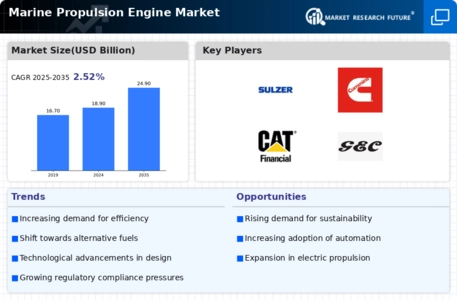Market Trends and Projections
Investment in Research and Development
Investment in research and development is a vital factor influencing the Global Marine Propulsion Engine Market Industry. Companies are allocating substantial resources to innovate and develop next-generation propulsion technologies that enhance efficiency and reduce environmental impact. This focus on R&D is evident in collaborations between manufacturers and research institutions aimed at creating more efficient engines. For instance, initiatives to develop hydrogen fuel cells and other alternative fuels are gaining traction. Such investments are expected to yield significant advancements in propulsion technology, thereby supporting the market's expansion.
Rising Demand for Sustainable Solutions
The Global Marine Propulsion Engine Market Industry is increasingly influenced by the demand for sustainable and environmentally friendly solutions. As regulations tighten globally regarding emissions, shipbuilders are compelled to adopt cleaner technologies. This shift is evident in the growing interest in hybrid and electric propulsion systems, which not only reduce carbon footprints but also enhance fuel efficiency. For instance, the International Maritime Organization has set ambitious targets for reducing greenhouse gas emissions from shipping, which is likely to drive innovation in propulsion technologies. The market is projected to reach 18.9 USD Billion in 2024, reflecting this trend towards sustainability.
Technological Advancements in Engine Design
Technological advancements play a pivotal role in shaping the Global Marine Propulsion Engine Market Industry. Innovations such as digital monitoring systems, advanced materials, and improved combustion techniques are enhancing engine performance and reliability. These developments are not only increasing efficiency but also reducing operational costs for ship operators. For example, the integration of IoT technologies allows for real-time monitoring of engine performance, leading to predictive maintenance and reduced downtime. As these technologies become more prevalent, they are expected to contribute to the market's growth, with projections indicating a rise to 24.9 USD Billion by 2035.
Growth in Global Trade and Shipping Activities
The Global Marine Propulsion Engine Market Industry is significantly driven by the growth in global trade and shipping activities. As economies expand and consumer demand increases, the need for efficient shipping solutions becomes paramount. The World Trade Organization reports a steady increase in global merchandise trade, which in turn fuels the demand for new vessels equipped with advanced propulsion systems. This trend is likely to continue, with the market expected to grow at a CAGR of 2.52% from 2025 to 2035. The expansion of shipping routes and the emergence of new markets further bolster this growth.
Regulatory Compliance and Environmental Standards
Regulatory compliance is a critical driver within the Global Marine Propulsion Engine Market Industry. Governments worldwide are implementing stringent environmental regulations aimed at reducing emissions from marine vessels. Compliance with these regulations often necessitates the adoption of advanced propulsion technologies, such as LNG engines and scrubbers. The European Union, for instance, has introduced the Sulphur Directive, which mandates a significant reduction in sulphur emissions from ships. As a result, ship operators are increasingly investing in modern propulsion systems to meet these standards, thereby propelling market growth.





